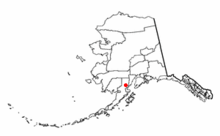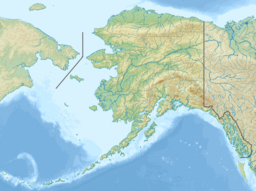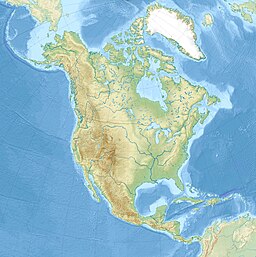Iliamna Lake
| Iliamna Lake | |
|---|---|
| |
 Satellite image of Iliamna Lake | |
| Location | Lake and Peninsula Borough, Alaska |
| Coordinates | 59°32′12″N155°01′28″W/ 59.53667°N 155.02444°W[1] |
| Lake type | oligotrophic |
| Primary inflows | Newhalen River,Iliamna River,Pile River,Copper River |
| Primary outflows | Kvichak River |
| Basincountries | United States |
| Max. length | 77 mi (124 km)[2] |
| Max. width | 22 mi (35 km)[2] |
| Surface area | 1,012.5 sq mi (2,622 km2)[2] |
| Average depth | 144 ft (44 m)[2] |
| Max. depth | 988 ft (301 m)[2] |
| Water volume | 115.5 km3(27.7 cu mi)[2] |
| Residence time | 7.8 years[2] |
| Surface elevation | 46 ft (14 m)[1] |
| Settlements | Iliamna,Newhalen,Kokhanok,Pedro Bay,Igiugig |
| References | [1][2] |
Iliamna LakeorLake Iliamna(Yup'ik:Nanvarpak;Dena'ina Athabascan:Nila Vena) is a lake in southwestAlaska,at the north end of theAlaska Peninsula,betweenKvichak BayandCook Inlet,about 100 miles (160 km) west ofSeldovia, Alaska.[1]It shares a name with theIliamna River,which flows into it, and the nearby community ofIliamna, Alaska.
It is the largest lake inAlaska,7th largest lakein the United States, and twenty-fourth in North America. Covering about 2,600 km2(1,000 sq mi), Iliamna Lake is 77 miles (124 km) long and up to 22 miles (35 km) wide, with a maximum depth of 988 feet (301 m). Through theKvichak River,its waters drain intoBristol Bay.[3]
History[edit]

Name[edit]
The lake is marked as 'Oz[ero] Bol[shoy] Ilyamna' (Big Ilyamna Lake) on theRussian Hydrographical Department's Chart 1455, published in 1852. On an earlier Russian map, from 1802, the lake was named 'Oz[ero] Shelekhovo' (Lake Shelekov) after Russian explorerGrigory Shelekhov.According to G.C. Martin, of theUnited States Geological Survey,Iliamna is said to be "the name of a mythical greatblackfishsupposed to inhabit this lake, which bites holes in thebidarkasof bad natives. "[1]

The name Iliamna is derived from the InlandDena'ina AthabascannameNila Vena,which means island's lake.[4]
Economy[edit]
Williamsport-Pile Bay Road portage[edit]
Originally constructed by theAlaska Road Commissionduring the mid 1930s, the Williamsport-Pile Bay Road is a utility-class road maintained by theAlaska Department of Transportation & Public Facilities.Connecting Pile Bay on the lake's northeast side with Williamsport, a tiny settlement on the Iliamna Bay ofCook Inlet(about 100 miles (160 km) southwest ofHomer), the road is 15.5 miles (24.9 km) long and one lane wide with four bridges. The Williamsport-Pile Bay Road is maintained as a gravel utility road for the purpose of hauling boats and freight, and is not intended for general purpose use. The road allows boats small enough to be hauled across the road's bridges an opportunity toportagefrom Cook Inlet toBristol Bay,saving a trip on the open ocean which involves traveling around theAlaska Peninsula.For this and other reasons, the road is also believed to significantly reduce fuel costs for the Lake Iliamna and Bristol Bay regions.
Populated places[edit]
The villages ofIliamna,Newhalen,Kokhanok,Pedro Bay,Pope-Vannoy LandingandIgiugiglie on the shores of Iliamna Lake.
Flora and fauna[edit]
Iliamna Lake is noted for itssport fishing.The three primary targets of anglers in the lake are trout, salmon, and grayling. August through September is prime time for catching fatrainbow trout,some of which exceed 28 inches long. The Kvichak River Policy (the drainage of Lake Iliamna) iscatch and releaseon trout (and all other native fish), but not on salmon. Sockeye (red) and Chinook (king) salmon are consistently found in the lake and are open to harvest underAlaska Department of Fish and GameRegulations. Lake Iliamna also has one of few populations offreshwater sealsin the world.[5]It also serves as a nursery for the largest red salmon run in the world. Red salmon spend half of their 5-year lifespan in fresh water. This is longer than any other species of salmon.
Monster Legend[edit]
Local residents have a number of stories about the alleged Iliamna Lake Monster, an unknown aquatic creature.[6]Speculation exists that reported sightings may be of an undocumented population ofwhite sturgeon.If true, this would be the most northerly population known to exist, just a few hundred miles from the Arctic Circle.Jeremy Wade,presenter of Animal Planet's River Monsters, is among those who speculate these sightings of a reputed "monster" are of a white sturgeon. Others believe that it is aPacific sleeper shark.Evidence of this is corroborated by a 2012 YouTube video that shows a smaller Pacific sleeper shark in Lake Iliamna. There were several new sightings in 2017. The Anchorage Daily News once offered a prize of $100,000 for concrete proof of its existence.
See also[edit]
References[edit]
- ^abcdeU.S. Geological Survey Geographic Names Information System: Iliamna Lake
- ^abcdefghMathisen, Ole A.; Norma Jean Sands; Norma Haubenstock (July 2002)."Trophic ranking of biota in Iliamna Lake, Alaska"(PDF).Verh. Internat. Verein. Limnol.28.Stuttgart: 1060–1065.Retrieved2008-11-13.[dead link]
- ^"Profile of the People and Land of the United States".US Department of Interior,National Atlas of the United States.Archived fromthe originalon 2012-09-15.
- ^Kari, James; Russell Kari, Priscilla (1982).Dena'ina E\nena: Tanaina Country.Alaska Native Language Center. p. 17.
- ^"Resident Harbor Seals (Phoca vitulina) in Iliamna Lake, Alaska: Summer Diet and Partial Consumption of Adult Sockeye Salmon (Oncorhynchus nerka)",Aquatic Mammals,July 2008.
- ^"Pride of Bristol Bay: Catching the Iliamna Lake Monster".28 October 2020.
External links[edit]
- "Detailed USGS topographic map"(JPEG).United States Topographic Maps 1:250,000.US Geological Survey map hosted by theUniversity of Texas.1983.


